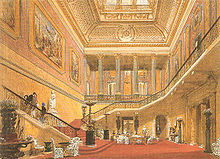Lancaster House
| Lancaster House | |
|---|---|
 | |
 | |
| General information | |
| Architectural style | Neo-classical |
| Location | St James's London, SW1 United Kingdom |
| Coordinates | 51°30′14″N 0°8′21″W / 51.50389°N 0.13917°W |
| Current tenants | Foreign, Commonwealth and Development Office |
| Construction started | 1825 |
| Completed | 1840 |
| Owner | HM Government |
| Technical details | |
| Floor count | Three (plus basement) |
| Design and construction | |
| Architect(s) | Benjamin Dean Wyatt (interior and exterior) Sir Charles Barry (interior) Sir Robert Smirke (interior) |
| References | |
Listed Building – Grade I | |
| Official name | Lancaster House |
| Designated | 5 February 1970 |
| Reference no. | 1236546 |


Lancaster House (originally known as York House and then Stafford House) is a
History
Construction of the house commenced in 1825 for the
The completed building was three floors in height, the State rooms being on the first floor or
The Sutherlands’ liberal politics and love of the arts attracted many distinguished guests, including factory reformer the
Queen Victoria is said to have remarked to the 2nd Duchess of Sutherland on arriving at Stafford House, "I have come from my House to your Palace." With its ornate decoration and the dramatic sweep of the great staircase, the Grand Hall is a magnificent introduction to one of the finest town houses in London. The house went out of royal favour after the 3rd Duchess died, in 1888, and her husband married his mistress within months.[5]
In 1912 the lease was purchased by the Lancastrian industrialist and philanthropist Sir William Lever, 1st Baronet (later 1st Viscount Leverhulme) who renamed it in honour of his native county of Lancashire and presented it to the nation in the following year.[2]: 158–161
Since 1922 the building has housed the
The allied government's European Advisory Commission on the political and social future of Europe after World War II met here the through 1944 into 1945. In January 1947 a special envoy meeting on affairs concerning occupied Austria was hosted here. The year 1956, the house saw the signing of the agreement of independence for Malaya. In 1961, South Africa affirmed its intention to become a republic, inside the Commonwealth. In 1979 it was the scene of the Lancaster House Agreement, which led to the independence of Rhodesia, now Zimbabwe, from the United Kingdom.[2]: 161
The house was the venue for the 10th G7 summit in 1984 and the 17th G7 summit in 1991.[9] A new 35-foot-long table was built for the Long Gallery, where the main negotiating sessions were planned in 1991.[10]
Prime Minister Theresa May gave a speech at Lancaster House in January 2017 outlining Britain's intended future relationship with the European Union following the 2016 United Kingdom European Union membership referendum which resulted in a vote to leave. The speech is commonly referred to in the media, and in political discourse, as the "Lancaster House speech".[11]
In popular culture
Winston Churchill commented that towards the end of the 19th century, "glittering parties at Lansdowne House, Devonshire House or Stafford House (Lancaster House) comprised all the elements which made a gay and splendid social circle in close relation to the business of Parliament, the hierarchies of the Army and Navy, and the policy of the State".[12]
Lancaster House has been extensively used as a filming location. It has stood in for
See also
- The Lancaster House Conferences
- The Lancaster House Treaties
- The Lancaster House Agreement
- The Government Wine Cellar
References
- ^ a b c Historic England. "Lancaster House (Grade I) (1236546)". National Heritage List for England. Retrieved 18 June 2015.
- ^ ISBN 978-0711233669.
- ^ Walford, Edward. "St James's Palace Pages 100-122 Old and New London: Volume 4. Originally published by Cassell, Petter & Galpin, London, 1878". British History Online. Retrieved 13 July 2020.
- ^ Chopin in Britain PhD Thesis Durham University by Peter Willis pp138-147. He played some Mazurkas and a Mozart Duet
- ISBN 978-1-4736-4775-6.
- ^ "From the archive: Inside the UK Government's Cellar". Decanter. 16 July 2021. Retrieved 25 April 2023.>
- ^ Goldsmith, Belinda (1 March 2013). "Britain's government sells French wine to pay its drinks bill". Reuters. Retrieved 1 March 2013.
- ^ "Historic Houses: Lancaster House, St James's. 'London Museum Stafford House'". National Archives. Retrieved 25 April 2023.
- ^ Japan, Ministry of Foreign Affairs (MOFA): Summit Meetings in the Past.
- ^ Apple Jr., R.W. (15 July 1991). "Reporter's Notebook; British Hosts, Being British, Plan an Understated Splendor". The New York Times. Retrieved 29 April 2011.
- ^ "Read Theresa May's Speech Laying Out the U.K's Plan for Brexit". Time Magazine. 17 January 2017. Retrieved 25 April 2023.
- ISBN 9780907871620.
- ^ "Where was King Ralph filmed?". British Film Locations. Retrieved 31 October 2017.
- ^ "Uncovering The Mystery Of The Book Of Secrets: Behind The Scenes At Buckingham Palace". Historic Cornwall. 18 January 2023. Retrieved 25 April 2023.
- ^ "Period Drama Film Location: Lancaster House". Lady and The Rose. 17 November 2019. Retrieved 25 April 2023.
- ^ "The King's Speech Filming Locations in England". Almost Ginger. 5 November 2021. Retrieved 25 April 2023.
- ^ "Filming Location Matching "Lancaster House, The Mall, St. James's, London, England, UK" (Sorted by Popularity Ascending)". IMDb.
- ^ "The Crown filming locations you can visit in real life". House and Garden. 7 November 2022. Retrieved 25 April 2023.
- ^ "The Importance of Being Earnest (2002) - IMDb" – via www.imdb.com.
- ^ "The Golden Bowl (2000) - IMDb" – via www.imdb.com.
Bibliography
- Yorke, James (2001). Lancaster House: London's Greatest Town House. Merrell Publishers Ltd. ISBN 9780385601153.
